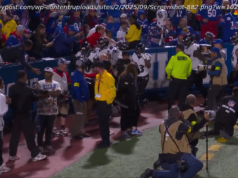Yet again! North Carolina voters are casting ballots for the second statewide election in a row just weeks after a major hurricane.
For a Southern state regularly exposed to hurricanes, call it an election Florence-style.
In 2016, North Carolina voters cast their ballots just four weeks after Hurricane Matthew unleashed devastating floodwaters on the state’s eastern half. This fall, they’re voting about seven weeks after Hurricane Florence sent rivers wildly bursting their banks.
That leaves North Carolina lawmakers quickly adjusting rules for voter registration, the state elections board struggling to track down storm-displaced voters, and activists complaining more needs to be done so all those upended by the epic flooding are able to vote.
The State Board of Elections is spending $400,000 for various types of ads to get out the post-hurricane vote. Legislators have extended the deadline for traditional voter registration by several days. And lawmakers will be back Monday for a daylong special session in which a House elections chief promises he’s open to suggestions about how to make the election run more smoothly.
Unlike the vote in 2016, this fall there’s no presidential race at the top of the ticket. The top statewide posts include elections for 120 House members and 50 senators, along with six constitutional amendments.
Matthew was so close to the election that the board did a mailing to people who had requested an absentee ballot to ensure they received a ballot, said Josh Lawson, general counsel for State Board of Elections. Florence is different, he said, because the storm struck more than seven weeks before Election Day.
« This happened so far in advance, it’s not about making sure they have their ballot, » he said. « It’s about trying to make sure people are aware of their options to vote by mail or during the early voting. »
In a one-day special session on Oct. 2, the General Assembly directed the elections board to spend $400,000 from a fund used to publish voter guides for educating displaced residents about voting accessibility and coordinate with other agencies in publicizing voting options. The board also contracted with a marketing company to spend that money on a combination of media advising voters of their options, including absentee voting by mail, in-person early voting and Election Day voting, spokesman Patrick Gannon said via email.
The media include 15-second TV ads, 30-second radio spots, targeted Facebook advertising, half-page full-color ads in newspapers and static digital ads on various websites, Gannon wrote.
The board also is considering outdoor digital billboard ads.
Gannon said those ads will target 28 counties in eastern North Carolina hit the worst, writing « we believe the messages will get shared far and wide through social media » and other ways.
Legislators also agreed Oct. 2 to extend the deadline for traditional voter registration from Friday, Oct. 12, to Monday afternoon in nearly 30 eastern counties hit hardest by Florence.
But some complained that’s does little to help those who aren’t living at their usual address and don’t know where they’ll be living when their voter registration card arrives.
It’s « a half-hearted solution that will not address the dramatic loss of access to the ballot, » said Marcus Bass, vice chairman of the board Blueprint North Carolina, a network of about 40 nonprofit groups seeking equity on social justice issues.
Blueprint and others support changes such as « mega-voting centers » in large retail locations in the storm-impacted counties from early voting through Election Day. They also want mobile polling units at early voting sites and extended weekend hours for same-day voting.
Legislators return Monday to consider more specific funding requests from Gov. Roy Cooper, whose office estimates nearly $13 billion in damage when Florence dumped more than 30 inches (75 centimeters) of rain in parts of North Carolina, flooding tens of thousands of buildings. At least 40 people died in the state.
Asked whether further fall election changes would be considered Monday, Republican Rep. David Lewis of Harnett County, the House elections co-chairman, texted Friday that no one requested changes but « I’d be receptive to reviewing them. »
In addition to state efforts to find displaced voters, local groups on the ground are also trying to locate people no longer living at home. Michael Schachter, a retired community college math teacher who now works with get-out-the-vote efforts in New Bern through the Craven GOTV Coalition, said the group doesn’t even have enough people to go door-to-door to register people to vote because so many volunteers suffered damage in Hurricane Florence. Instead, volunteers registered voters at places where people gather, such as the library and box stores, he said.
« Once a person leaves their house, it’s hard to find them, » he said. « Maybe some of their neighbors know where they are, but that’s not always true. »
Coalition volunteers next plan to place signs in with an 800-number in neighborhoods so people can call to get rides to sites for early voting, which begins Wednesday.
If Florence affects voting as Matthew did, then one could expect little difference in turnout among registered voters between those in Florence counties and those elsewhere, according to an analysis by Michael Bitzer, a Catawba College political science professor who analyzes voting data.
Compared to the statewide turnout rate of registered voters at 68 percent, the Matthew-designated counties, as a group, had a 67 percent turnout rate. By race, 63 percent of registered black voters in Matthew counties cast a ballot, compared to 64 percent in non-Matthew counties.
While the hurricane could be the difference, the lower African-American turnout also could be attributed to not having a black presidential candidate running for president, Bitzer notes on his website, Old North State Politics .
« Even with the damage that Matthew caused in a significant portion of the state, people were willing to vote, » he said, but more waited until Election Day in Matthew-designated counties (34 percent) than in other counties (32 percent).






